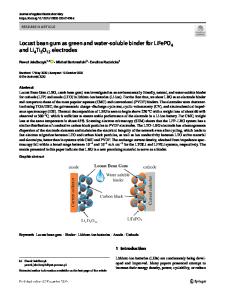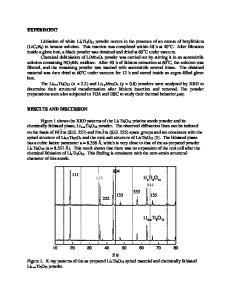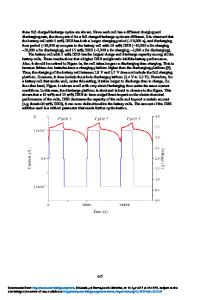Li-Ion Battery with LiFePO 4 Cathode and Li 4 Ti 5 O 12 Anode for Stationary Energy Storage
- PDF / 619,053 Bytes
- 5 Pages / 593.972 x 792 pts Page_size
- 27 Downloads / 342 Views
TRODUCTION
THE concerns over the environmental consequences from burning fossil fuels, along with their resource constrains, have spurred growing interest in renewable energy generated from sources such as solar and wind. However, the intermittent nature of the alternative energy sources necessitates the use of the effective energy storage system to dispatch the varied renewable power.[1–3] One potential technology is use of Li-ion batteries that are now being extensively developed for vehicle applications.[3] Unlike the portable and vehicle applications that have stringent requirements on energy/ power densities due to their weight and volume constrains, the stationary energy storage of renewable power puts more emphasis on cost-effectiveness, cycle stability, safety, etc. Accordingly, our efforts have focused on Li-ion battery chemistries using cost-effective anodes and cathodes of excellent structural and chemical stability and thus capable of a long cycle life. Particularly, we investigated the Li-ion batteries made from LiFePO4 cathode and Li4Ti5O12 anode using commercial electrolyte. Li4Ti5O12 demonstrates a specific capacity of 175 mAh/g with a flat discharge/charge profile at 1.55 V and is known for its ‘‘zero’’ straining Li-insertion/ deinsertion behavior and thus long cycle life.[4] The cycling voltage of Li4Ti5O12 with respect to lithium metal is relatively higher than that of graphite, which leads to a lower energy density by narrowing down the useful potential of the full cell. However, compared with graphite, Li4Ti5O12 possesses significant advantages for stationary applications in terms of long cycling stability WEI WANG and DAIWON CHOI, Scientists, are with the Pacific Northwest National Laboratory, 902 Battelle Boulevard, P.O. Box 999, Richland, WA 99354. Contact e-mails: [email protected], [email protected] ZHENGUO YANG, CEO, is with UniEnergy Technologies, LLC, 4333 Harbour Pointe Blvd SW, Unit A, Mukilteo, WA 98275. Manuscript submitted March 14, 2012. Article published online September 5, 2012 METALLURGICAL AND MATERIALS TRANSACTIONS A
and safety by avoiding the formation of unsafe solid electrolyte interface (SEI) layer caused by electrolyte decomposition at lower voltage (4000 deep cycles) for stationary energy storage systems. We have previously reported self-made LiFePO4 as the choice of cathode in a design of Li-ion battery for stationary energy storage over 700 cycles.[3] This article reports the improvement in long-term cyclability of a Li-ion battery consisting of LiFePO4 as cathode and Li4Ti5O12 as anode, in which commercial available materials were used with least modification for cost-effectiveness.
II.
EXPERIMENTAL
LiFePO4 and Li4Ti5O12 powders were obtained from commercial vendors. Ten weight percent Ketjen black was added to LiFePO4 and milled in a planetary mill for VOLUME 44A, JANUARY 2013—S21
8 hours (Retsch 100CM) at 400 rpm. In a subsequent study, single-walled carbon nanotubes (SWNTs) and multi-walled carbon nanotubes (MWNTs) were used as additives to further improve the conduc
Data Loading...











